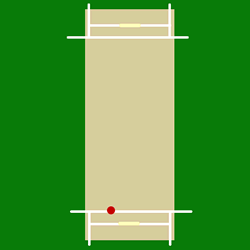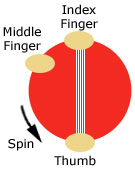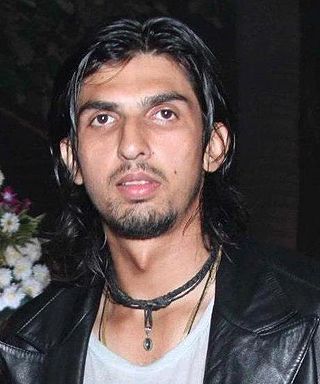
Leg spin is a type of spin bowling in cricket. A bowler who uses this technique is called a leg spinner. Leg spinners bowl with their right-arm and a wrist spin action. The leg spinner's normal delivery is called a leg break, which spins from right to left when the ball bounces on the pitch. For a right-handed batter, the ball breaks towards them from the leg side, hence the name 'leg break'.
A googly, also known as a wrong'un or Bosie, is a type of delivery in the game of cricket bowled by a right-arm leg spin bowler. It is different from the normal delivery for a leg-spin bowler in that it is turning the other way. The googly is not a variation of the typical off spin type of delivery, in that the cricket ball is presented from the bowler's hand in such a way that once the ball pitches; instead, it deviates in the opposite direction of a leg spinning type of delivery. It has also been colloquially referred to as the wrong'un, Bosie or Bosey, with the latter two eponyms referring to Bernard Bosanquet, the bowler who originally devised and began using the googly. He first employed it in July 1900, during the second innings of a County Championship match between Middlesex and Leicestershire at Lord's. In that game, Sam Coe became the first batter known to have been dismissed by a googly. During the Edwardian era, some considered its use to be an example of cheating.

Bowling, in cricket, is the action of propelling the ball toward the wicket defended by a batter. A player skilled at bowling is called a bowler; a bowler who is also a competent batter is known as an all-rounder. Bowling the ball is distinguished from throwing the ball by a strictly specified biomechanical definition, which restricts the angle of extension of the elbow. A single act of bowling the ball towards the batsman is called a ball or a delivery. Bowlers bowl deliveries in sets of six, called an over. Once a bowler has bowled an over, a teammate will bowl an over from the other end of the pitch. The Laws of Cricket govern how a ball must be bowled. If a ball is bowled illegally, an umpire will rule it a no-ball. If a ball is bowled too wide of the striker for the batsman to be able to play at it with a proper cricket shot, the bowler's end umpire will rule it a wide.

Fielding in the sport of cricket is the action of fielders in collecting the ball after it is struck by the striking batter, to limit the number of runs that the striker scores and/or to get a batter out by either catching a hit ball before it bounces, or by running out either batter before they can complete their current run. There are a number of recognised fielding positions and they can be categorised into the offside and leg side of the field. Fielding also involves trying to prevent the ball from making a boundary where four "runs" are awarded for reaching the perimeter and six for crossing it without touching the grass.

Leg before wicket (lbw) is one of the ways in which a batter can be dismissed in the sport of cricket. Following an appeal by the fielding side, the umpire may rule a batter out lbw if the ball would have struck the wicket but was instead intercepted by any part of the batsman's body. The umpire's decision will depend on a number of criteria, including where the ball pitched, whether the ball hit in line with the wickets, the ball's expected future trajectory after hitting the batsman, and whether the batsman was attempting to hit the ball.

This is a general glossary of the terminology used in the sport of cricket. Where words in a sentence are also defined elsewhere in this article, they appear in italics. Certain aspects of cricket terminology are explained in more detail in cricket statistics and the naming of fielding positions is explained at fielding (cricket).

In cricket, batting is the act or skill of hitting the ball with a bat to score runs and prevent the loss of one's wicket. Any player who is currently batting is, since September 2021, officially referred to as a batter regardless of whether batting is their particular area of expertise. Historically, batsman and batswoman were used, and these terms remain in widespread use. Batters have to adapt to various conditions when playing on different cricket pitches, especially in different countries; therefore, as well as having outstanding physical batting skills, top-level batters will have quick reflexes, excellent decision-making skills, and be good strategists.
Swing bowling is a bowling technique in cricket, in which the ball is made to curve through the air. This is in the hope that the change in the ball's flight path will deceive the batter and cause them to play the ball incorrectly. A bowler who uses this technique is called a swing bowler. Swing bowling is generally classed as a type of fast bowling.
Seam bowling is a bowling technique in cricket, whereby the ball is deliberately bowled to hit the ground on its seam(join with a seam or indentation), to cause a random deviation when it bounces. A bowler who uses this technique is called a seam bowler or seamer.

Spin bowling is a bowling technique in cricket, in which the ball is delivered relatively slowly but with rapid rotation, giving it the potential to deviate sharply after bouncing. A bowler who uses this technique is called a spinner, a spin bowler, or a slow bowler.
An outswinger is a type of delivery of the ball in the sport of cricket. In such a delivery the ball curves—or "swings"—out and away from the batter's body and the wicket. By contrast, an inswinger swings in toward the batter and the wicket. Outswingers are bowled by swing bowlers.
An inswinger is a type of delivery of the ball in the sport of cricket. In such a delivery the ball curves—or "swings"—in toward the batter's body and the wicket. By contrast, an outswinger swings away from the line of the batter and the wicket. Inswingers are bowled by swing bowlers.

An off cutter is a type of delivery in the game of cricket. It is bowled by fast bowlers.

Waqar Younis Maitla HI is a Pakistani cricket coach, commentator and former cricketer who captained Pakistan national cricket team. A right-arm fast bowler, he is widely regarded as one of the greatest bowlers of all time. He is the former head coach of the Pakistani cricket team. He was a part of the squad which finished as runners-up at the 1999 Cricket World Cup.
In the sport of cricket there are two broad categories of bowlers: pace and spin. Pace bowlers rely mostly on the speed of the ball to dismiss batsmen, whereas spin bowlers rely on the rotation and turn off the ball to deceive the batter.

A delivery or ball in cricket is a single action of bowling a cricket ball toward the batter. Once the ball has been delivered, batters may attempt to score runs, with the bowler and other fielders attempting to stop this by getting the batters out. When the ball becomes dead, the next delivery can begin.
Wrist spin is a type of bowling in the sport of cricket. It refers to the cricket technique and specific hand movements associated with imparting a particular direction of spin to the cricket ball. The other spinning technique, usually used to spin the ball in the opposite direction, is finger spin. Wrist spin is bowled by releasing the ball from the back of the hand, so that it passes over the little finger. Done by a right-handed bowler, this imparts an anticlockwise rotation to the ball, as seen from the bowler's perspective; a left-handed wrist spinner rotates the ball clockwise.
In cricket, a bowling machine is a device which enables a batsman to practise and to hone specific skills through repetition of the ball being bowled at a certain length, line and speed. It can also be used when there is no-one available to bowl, or no one of the desired style or standard.

Ishant Sharma is an Indian cricketer who has represented India in Tests, ODIs and T20Is. He is a 6 ft 4 in tall right-arm fast-medium bowler. At the age of 18, Sharma was called to join the Indian squad for the tour of South Africa in 2006–07. However, after receiving the call and organising travel arrangements, he was deselected. In reference to his height and lean physique in his Under-19 days, the bowler was nicknamed Lambu. In 2011, he became the fifth youngest player to take 100 Test wickets. Against South Africa in 2013, Ishant Sharma became the fifth quickest Indian to record 100 ODI wickets. While being a "rhythm" bowler, he still is considered one of the fastest Indian bowlers having bowled in excess of 150 km/h on several occasions in international cricket as well as the IPL, his fastest being 152.2 km/h bowled to Ricky Ponting on Boxing Day Test in 2011. In 2020, Indian government has awarded him the Arjuna Award to recognize his outstanding achievement in cricket. Sharma was a member of the Indian team that won the 2013 ICC Champions Trophy.

Cricket is a bat-and-ball game played between two teams of eleven players on a field, at the centre of which is a 22-yard pitch with a wicket at each end, each comprising two bails balanced on three stumps. Two players from the batting team, the striker and nonstriker, stand in front of either wicket holding bats, while one player from the fielding team, the bowler, bowls the ball toward the striker's wicket from the opposite end of the pitch. The striker's goal is to hit the bowled ball with the bat and then switch places with the nonstriker, with the batting team scoring one run for each of these exchanges. Runs are also scored when the ball reaches the boundary of the field or when the ball is bowled illegally.









